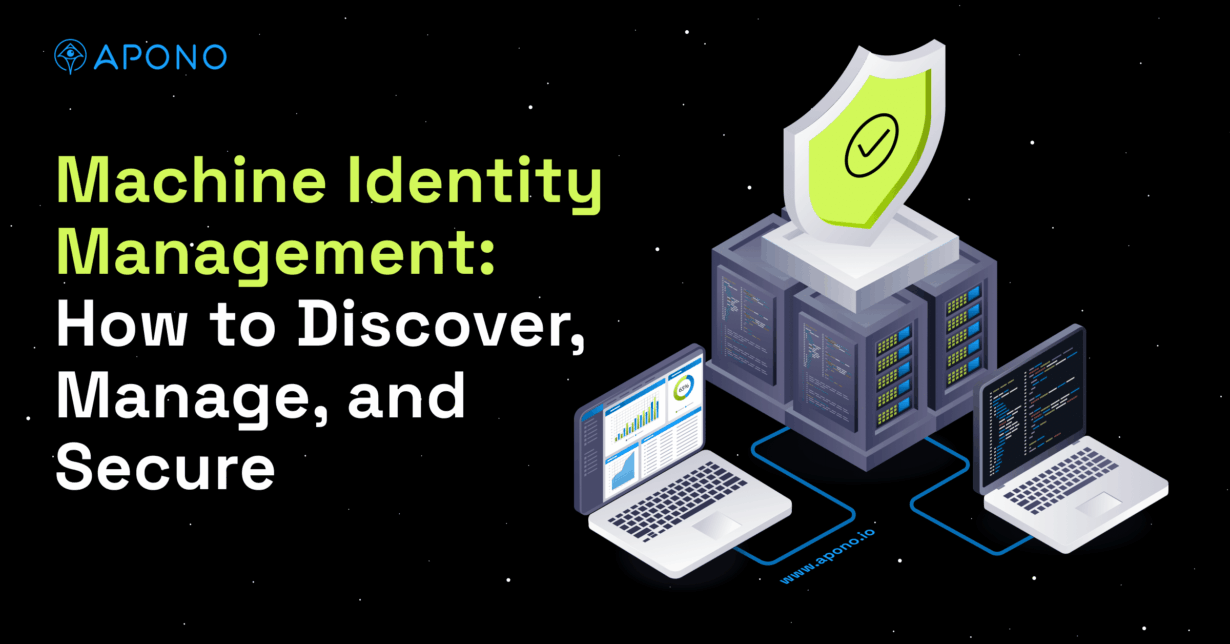Machine Identity Management: How to Discover, Manage, and Secure

The Apono Team
July 1, 2025

Machine identities have quietly become the backbone of digital infrastructure, outnumbering human users in most enterprise environments. While they don’t forget passwords or call tech support, they do introduce a unique set of security and operational risks.
Unlike human users, machine identities (like service accounts, API keys, bots, and microservices) often operate with highly permissive access rights and weak or nonexistent authorization policies. Machine identity management (MIM) brings clear security and compliance benefits when managed well. Without it, you face security risks like orphaned credentials and shadow identities.
Yet, for many organizations, machine identity management remains an afterthought. 69% of companies now manage more machine identities than human ones, but 72% admit that managing them is more difficult due to poor internal processes and inadequate tools. Taking control starts with machine identity management best practices, which we will explore in this article.
What is machine identity management, and why does it matter?
Machine identities are credentials used to authenticate and communicate with each other. These identities include API keys, code secrets, SSH keys, and certificates. Non-human identities (NHIs) must be audited, authenticated, and authorized like human user accounts.
Machine identity management encompasses the processes, tools, and policies used to discover, categorize, assign ownership, monitor, rotate, and revoke the credentials of machine identities. It involves managing the identities themselves, enforcing least privilege principles, and securing the integrity and trustworthiness of machine-to-machine communication. MIM ensures proper authentication while enabling full observability and a layer of trust for workloads (apps, APIs, and containers) and physical devices (IoT devices and mobile endpoints) alike.
What is the machine identity management lifecycle?
Machine identity lifecycle phases include creation, provisioning, credential issuance, usage monitoring, rotation, deprovisioning, and revocation. Each phase must be auditable and automated to maintain least privilege and compliance.
Why does machine identity management matter?
Today, machine identities in organizations outnumber human ones by as many as 1 to 45, yet many businesses admit to having little to no oversight over them. This gap exists because traditional IAM solutions often overlook machine identities, leaving many undiscovered, unmanaged, or misconfigured.
These shadow machine identities are prime targets for attackers, who can exploit them to move laterally across networks, exfiltrate sensitive data, or disrupt critical systems—all without triggering traditional security alarms. To close this gap, you have to shift your focus to modern identity-first security strategies that treat machine identities with the same rigor as human ones, incorporating best practices like continuous discovery, policy enforcement, and automated lifecycle management. We’ll explore these strategies and more later in the article.
With effective machine identity management practices in place, you can reduce the risk of a breach while supporting compliance efforts in today’s dynamic environments, where cloud services and machine identities scale far faster than InfoSec teams can keep up.
4 Critical Threats to Machine Identity Management
As your organization scales, so does the sprawl of machine identities. The most critical hurdles impacting machine identity management today include:
1. Overprivileged Access
Developers often (wrongfully) assume that machine identities will only perform what other systems instruct them to do, never straying beyond their intended scope or falling into the wrong hands. As a result, machine identities and non-human identities are frequently granted broad permissions. Over-permissioning increases the blast radius in the event of a compromise, allowing attackers to infiltrate your systems and access sensitive data.
Example Threat
A harrowing example is the 2024 BeyondTrust API key breach, attributed to a lack of credential rotation and excessive access.
2. Lack of Observability
You can’t manage or audit machine identities you can’t see. Without real-time monitoring and robust logging policies, detecting suspicious activity tied to machine identities becomes almost impossible—often until it’s too late. Additionally, enforcing compliance across systems becomes a major challenge without a well-maintained catalog of all machine identities. This lack of visibility creates fertile ground for other risks, such as shadow machine identities and privilege creep.
Example Threat
Just look at what happened during the 2023 Okta support system breach, in which attackers leveraged a poorly monitored service account.
3. Shadow Machine Identities
Untracked and unmanaged machine identities include API keys, certificates, and service accounts that operate outside the visibility of security teams. When compromised, they often trigger no alerts. Undetected by traditional IAM tools, these rogue identities serve as ideal entry points for threat actors.
Example Threat
The 2023 Microsoft SAS token leak is a perfect example of how a long-lived token functioned as a shadow machine identity with no expiration or oversight.
4. Lifecycle Management Inconsistencies and Policy Drift
As annoying as it can be, human users are usually required to reset passwords periodically, enforced by IAM policies. However, machine identities often lack a clear owner and rely on static credentials that can remain unchanged for months or even years.
Because machines don’t go through standardized onboarding or offboarding, their lifecycle is rarely managed consistently like humans in an organization. This results in the sprawl of zombie services, orphaned credentials, policy drift, and unauthorized access, all weakening your overall security posture.
Example Threat
You only need to look at the 2024 Internet Archive Zendesk exposure for a warning on how unrotated, static tokens and ungoverned lifecycle practices can expose systems.
Table 1: MIM Threats and Examples
| Threat | Description | Real World Example |
| Overprivileged access | Machine identities are often granted excessive permissions under the assumption they will behave predictably. | BeyondTrust API Key Breach (2024): Involved an overprivileged, static API key that was exploited due to a lack of rotation. |
| Lack of observability | Without visibility, real-time monitoring, or logging, it’s nearly impossible to detect NHI misuse. | Okta Support System Breach (2023): Attackers used a poorly monitored service account to gain unauthorized access. |
| Shadow machine identities | Unmanaged identities, such as API keys or certificates that exist outside of IAM visibility. When compromised, they are rarely detected and easily exploited. | Microsoft SAS Token Leak (2023): A long-lived token granted full access to Azure data without expiration or oversight. |
| Lifecycle management inconsistencies and policy drift | Unlike human accounts, machine identities often have static credentials and no consistent lifecycle processes. | Internet Archive Zendesk Exposure (2024): Unrotated static tokens enabled attackers to access hundreds of thousands of support tickets. |
5 Best Practices for Discovering, Securing, and Managing Machine Identities
Fortunately, these threats can be mitigated. Organizations that apply these foundational MIM best practices can regain control, reduce risk, and move closer to zero trust.
1. Less is Best: Minimize Machine Identity Privileges
Most security incidents and breaches stem from one root issue: excessive access privileges. It can be a long-forgotten service account with admin rights or an API key left in a config file that made it to a public repository undetected. Unmanaged, overly permissive machine identity access privileges can lead to costly breaches or, in the best-case scenario, a public embarrassment to your brand.
What can you do?
Enforce short credential lifetimes and implement Just-in-Time (JIT) and Just-Enough Privileges (JEP) principles in your machine identity management policies.
- Just-Enough Privileges: Permissions are granularly scoped to a specific action or resource.
- Just-in-Time Access: Access is granted dynamically based on operational needs for a limited and pre-set time window, after which access is automatically revoked.
Following these principles ensures that NHIs and machine identities get just the minimum permissions required to perform an action, only for the duration of time they need them. These practices also align with zero trust principles by eliminating implicit trust and limiting access to a time window and specific context.
In complex environments where machine identities are created programmatically (like with CI/CD functions or serverless architectures), JIT and JEP are essential for scaling securely. Keep in mind that only automation can enforce JIT at the cloud scale without slowing your teams down. Manual permission scoping doesn’t scale—automation ensures every identity gets only the access it needs, only when it’s needed.
2. You Can’t Protect What You Can’t See: Automate Machine Identity Discovery and Inventory
Machine identities often sprawl in the background, provisioned by infrastructure as code tools, spun up by scripts, or created for testing and never cleaned up. Without a comprehensive, up-to-date catalog of all machine identities, it’s impossible to consistently apply access policies, monitor behavior, enforce compliance, and stay secure.
Unmanaged shadow identities create dangerous gaps in your security posture and serve as stealthy entry points for attackers, as they typically carry excessive permissions and stay active long past their intended use.
What can you do?
Automate the discovery and classification of machine identities across your stack. Use tools that can scan your cloud environments and IAM databases to identify credentials (like secrets, tokens, certificates) and then attribute them to actual machine identities. After all, you can’t protect what you can’t see—automated discovery reveals hidden machine identities and keeps your inventory current in real time.
This second step—identity attribution—is just as critical. Credentials alone don’t tell you which service, application, or workload created or owns them, especially in dynamic environments using infrastructure-as-code or ephemeral services. Mapping each credential to an owning system, usage context, and lifecycle stage ensures you’re not just building a list of secrets but constructing a complete machine identity inventory.
With full, real-time visibility into both credentials and their associated identities, you can detect orphaned or unused credentials, flag over-privileged non-human identities, track machine identities throughout their lifecycle, and enforce consistent policies.
3. Beyond Discovery: Monitor and Audit Machine Identity Activity
Machine identities don’t behave like human users. They don’t log in at predictable times or exhibit human-like workflows, making traditional anomaly detection methods ineffective. Instead, organizations must develop behavioral baselines for each machine identity, tracking expected usage patterns over time.
Without continuous monitoring and analysis, you risk missing privilege escalations or signs of credential compromise. This point of vulnerability weakens your security posture and complicates compliance with standards like SOC 2, GDPR, PCI DSS, ISO 27001, and HIPAA.
What can you do?
Implement continuous logging and behavioral monitoring for all machine identities. Track when, where, and how they’re used with audit logs that capture access requests, permissions granted, and resources accessed. Automation turns raw logs into real-time insights, detecting risky behavior before it becomes a breach.
Advanced security solutions can flag deviations from normal behavior, such as a CI/CD service account accessing a production database it’s never touched before. These anomalies often precede or indicate credential compromise, privilege escalation, or lateral movement. By combining audit trails with AI-driven threat detection and behavioral analytics, your security team can proactively detect and respond to threats before they become breaches.
4. Un-silo Your MIM: Centralize Access Control
In most organizations, access to cloud platforms, SaaS software, databases, CI/CD tools, and internal services is managed in silos. This fragmented approach makes it nearly impossible to maintain visibility and enforce consistent policies, not to mention the challenge of detecting privilege inconsistencies across environments.
In reality, this means that teams rely on manual processes or ad-hoc permissions that are difficult to audit and easy to abuse. Over time, this leads to inconsistent enforcement of security policies across identities and an increased risk of misconfiguration and unauthorized access.
What can you do?
Adopt a centralized access management strategy that brings all human and machine identity permissions under a unified framework. This allows you to apply least privilege policies consistently and reduce manual overhead. Automated policy enforcement removes guesswork and human error, ensuring consistent controls across every environment.
The best cloud-native access management platforms offer a single control layer over permissions across cloud and on-prem environments, allowing teams to manage access flows without compromising on agility or security.
5. Keep Them Spinning: Automate Credential Rotation
Machine identities that rely on static credentials that don’t change or expire are vulnerabilities waiting to be exploited. This is especially true if the NHI is not logged or monitored. These stale credentials can be low-hanging fruit for threat actors. Worse, a single leak can compromise numerous components or systems in your stack if the same credentials are reused across systems or embedded in public-facing code.
What can you do?
Automate the expiration and rotation of all machine identities’ credentials, with short validity periods for secrets. Static secrets are sitting targets, and manual rotation at scale is unrealistic; only automation can ensure secrets expire on time.
In addition, schedule refreshes on each deployment or use of a machine identity on any system or service. You can employ tooling that integrates with your CI/CD pipeline and secret management solutions to enforce these policies at scale.
Machine Identity Management Use Cases in Action
The best practices we discussed offer a strong foundation, but what do they look like in real-world environments? Below, we walk through two scenarios where a robust MIM strategy leveraging a cloud-native access management platform resolves the challenges.
Protecting CI/CD Pipelines, Workloads, and Automated Deployments
Let’s imagine a scenario in action: CI/CD pipelines are highly dynamic and automated environments. New resources and identities are spun up on the fly, with little to no InfoSec oversight. Machine identities for build agents, deployment scripts, and container orchestrators often require access to resources, but too frequently, they’re granted privileged and static credentials.
How Apono helps:
Apono brings JIT and JEP automation for machine identities in your development workflows and CI/CD pipelines. Fully integrated with your CI/CD stack, the platform ensures that every non-human identity gets only the minimum access required, only when needed, and for a limited time. Forget about manual provisioning, and stop relying on static code scanners to catch code secrets hiding in public code or configuration files.
Contextual Application Access to Cloud Resources
Here’s another scenario. Applications in microservices or cloud-native architectures routinely access services and resources (like databases and APIs), programmatically creating and using machine identities authenticated using tokens, certificates, or service account passwords. If all these credentials are not managed adequately, they become a cloud security risk. Moreover, without adequate oversight or ownership of machine identities in your systems, it becomes impossible to track access, enforce policies, or meet compliance requirements.
How Apono helps:
Apono centralizes and automates access control management and MIM policy enforcement for applications and their machine identities. Auto-expiring, granular permissions, comprehensive audit logs, and automated workflows reduce the operational risks presented by unmanaged machine identities. Cloud-native teams can finally enforce granular access policies for machine identities, without slowing down deployments or burdening DevOps with manual IAM tasks.
Why is automation essential for machine identity management?
These use cases above highlight how automation bridges the gap between security and scale, ensuring machine identities are governed without slowing innovation.
You can’t manually manage machine identities in cloud-native, API-driven, codified environments. No human can. The speed at which non-human identities are spun up programmatically demands capabilities that traditional identity governance tools do not have. Reliance on manual processes is a recipe for privilege sprawl and shadow NIHs. Plus, very exhausted InfoSec teams.
Since automation of machine identity generation is what created many of the challenges in MIM, it is essential to close these gaps. Automating dynamic policy enforcement, credential rotation, and consistent machine identity lifecycles ensures your identities are secure without slowing down DevOps workflows or overwhelming your InfoSec teams.
Apono is a cloud-native access management platform purpose-built to automate the full lifecycle of machine identity access. It enforces JIT and JEP by default, eliminates standing privileges with auto-expiring permissions, and provides centralized visibility through rich audit logs. Secure your machine identities without slowing innovation with fast, compliant, and secure access across your stack.
See how Apono automates machine identity management at scale—request a demo today.







